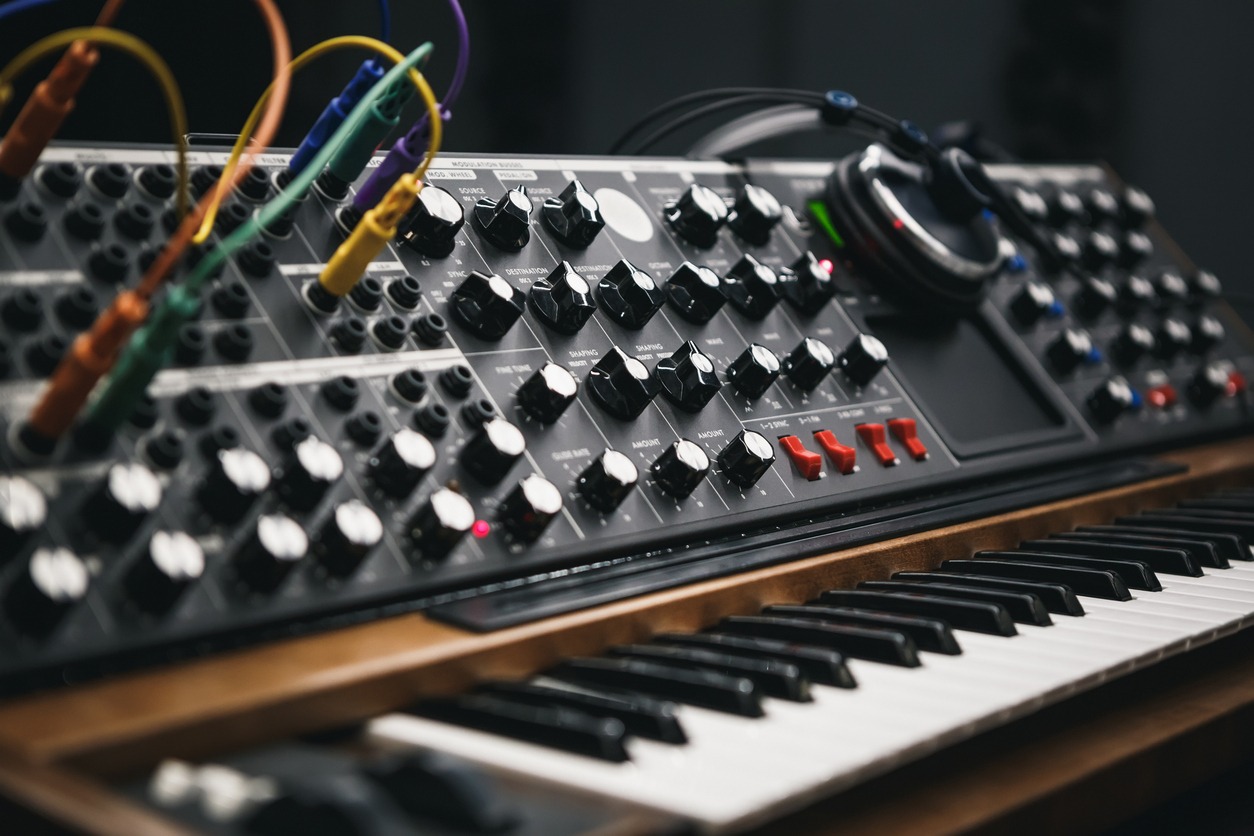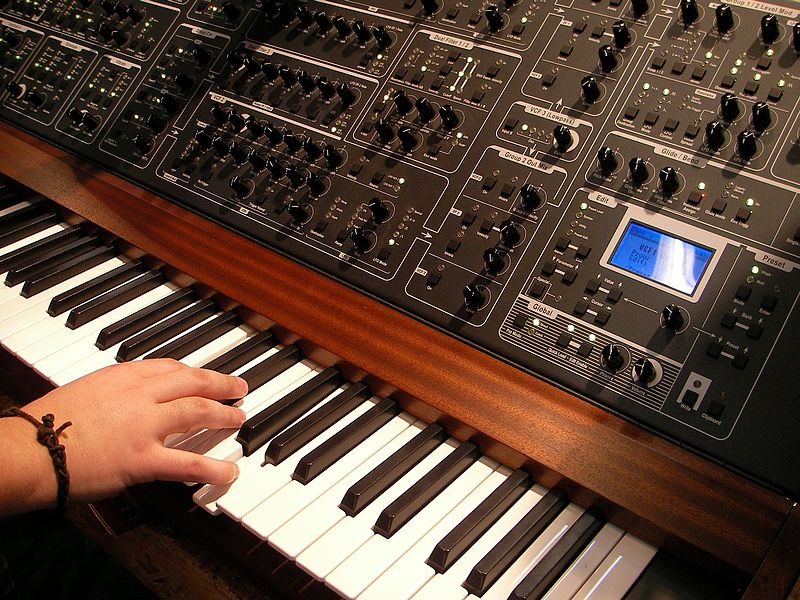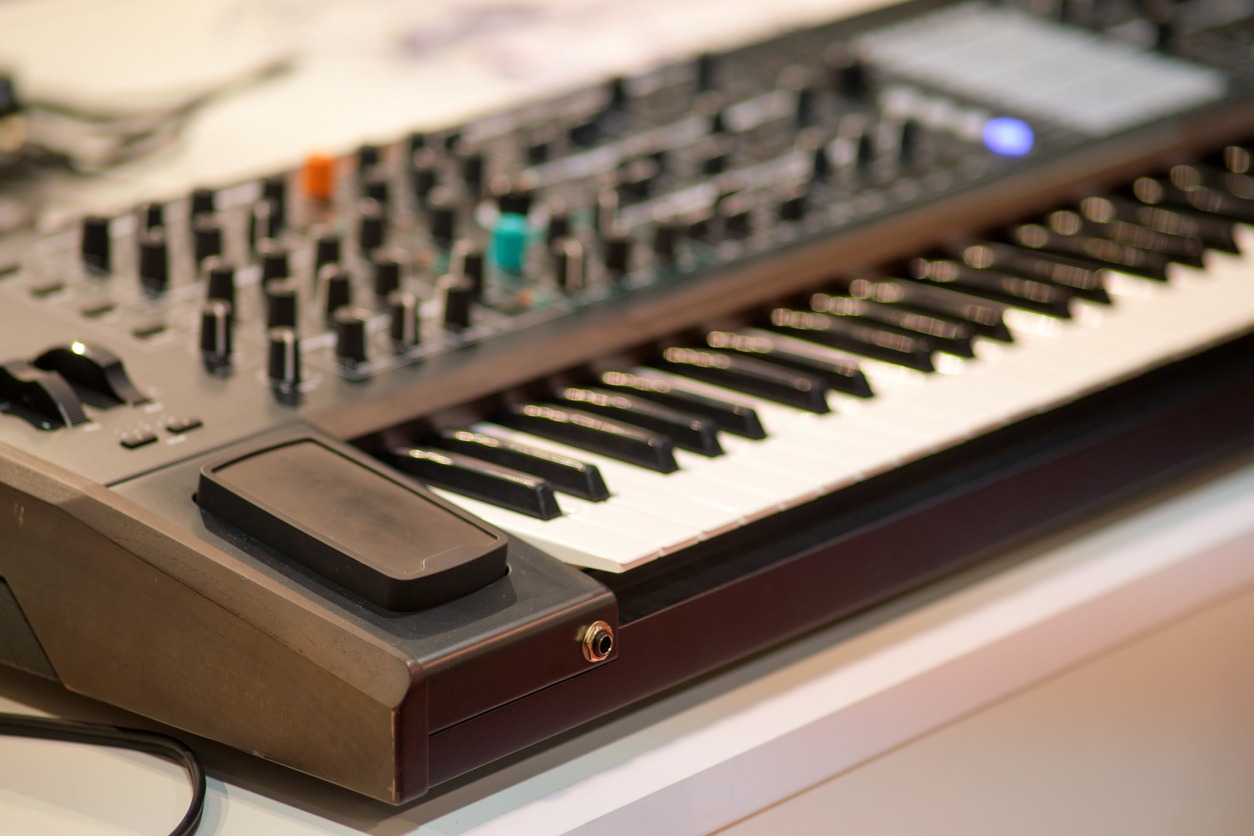The rise of analog synthesizers in the 1980s marks a revolutionary era, transforming the soundscape of an entire decade. These synthesizers, with their unique and distinctive auditory qualities, not only introduced new musical possibilities but also became symbolic of the ’80s music scene. From pop to rock and new wave to electronic, the influence of analog synthesizers was ubiquitous, imprinting its signature sound across various genres.
The 1980s, often nostalgically recalled for its bold fashion and vibrant culture, was equally groundbreaking in its musical innovations, largely thanks to the widespread adoption of analog synthesizers. In this article, we are going to discuss analog synthesizers in detail. We will discover how their distinctive sound influenced the music in the 1980s.
The Emergence of Analog Synthesizers
The story of analog synthesizers, which became a cornerstone of 1980s music, begins in the preceding decades when these innovative instruments started to evolve from bulky, complex machines to more accessible and musician-friendly tools. The emergence of analog synthesizers marked a significant shift in the musical landscape, paving the way for the distinctive sounds that would define the ’80s.
Historical Context and Development
In the 1960s and 1970s, early synthesizers like the Moog and ARP were groundbreaking but often prohibitively expensive and complex, primarily used by experimental musicians and in academic settings. The late 1970s witnessed key developments in synthesizer technology, making these instruments smaller, more affordable, and user-friendly. This democratization of synthesizers allowed a broader range of musicians to experiment with electronic sounds.
Pioneers and Early Adopters
Bands like Kraftwerk and artists such as Giorgio Moroder were among the early adopters who explored the potential of synthesizers, influencing genres like electronic music and disco. As synthesizers became more accessible, they started appearing in mainstream pop and rock music. Artists like Pink Floyd, The Who, and Stevie Wonder incorporated synthesizer sounds into their compositions, showcasing the instrument’s versatility.
The Synthesizer in the 1980s
By the dawn of the 1980s, synthesizers had become integral to the music production process. Their unique timbres and textures were central to the sound of the decade. Analog synthesizers were used in various ways, from creating ambient soundscapes to serving as the lead instrument in a track. They were no longer just a novelty but a fundamental aspect of musical expression.
Key Features and Capabilities
Analog synthesizers are known for their warm, rich tones produced by analog oscillators and filters. This contrasted with the cleaner, more digital sounds that would emerge later. The 1980s saw innovations in synthesis techniques, including subtractive, additive, and FM synthesis, each contributing to the diverse sound palette available to musicians.
The emergence of analog synthesizers was more than just a technological advancement; it represented a shift in the musical paradigm. As these instruments became more integrated into the fabric of music production, they not only shaped the sound of the 1980s but also laid the groundwork for future genres and styles in electronic music.
Characteristics of Analog Synthesizers
Analog synthesizers, the driving force behind the iconic soundscapes of the 1980s, possess unique characteristics that set them apart from other musical instruments, particularly their digital counterparts. These characteristics not only defined the sound of a generation but also revolutionized music production and composition.
- Analog Signal Path: Analog synthesizers generate sound through an entirely analog signal path using voltage-controlled oscillators, filters, and amplifiers. This method produces a warmth and richness in tone that is often described as more ‘organic’ compared to digital synthesis. The slight imperfections and instabilities in analog circuitry, such as oscillator drift, add character and depth to the sound, which became a beloved feature of these instruments.
- Subtractive Synthesis: Subtractive synthesis, the most common method used in analog synthesizers, involves shaping sound by removing harmonics from a rich waveform. This process is achieved using various filters and modulators. This technique allows for a wide range of sounds, from deep basses to piercing leads and lush pads, making analog synthesizers extremely versatile in music production.
- Oscillators and Waveforms: Analog synthesizers typically offer a selection of core waveforms (sine, square, triangle, and sawtooth) from their oscillators. Each waveform has a distinct tonal quality. Many analog synths feature multiple oscillators, allowing for the layering of different waveforms to create complex and rich sounds.
- Filters: Filters are crucial in sculpting the synthesizer’s sound. Low-pass filters, which cut off frequencies above a certain threshold, are particularly characteristic of analog synths, giving them their distinctive warm and mellow sound. Adjusting the resonance of filters and using envelope generators further manipulates the sound, adding dynamics and expression to the synthesis.
- Modulation and LFOs: Low-Frequency Oscillators (LFOs) and other modulation sources in analog synthesizers are used to add movement and texture to the sound. This can create effects like vibrato, tremolo, and sweeping filters. The tactile knobs and sliders for modulation on analog synthesizers offer musicians hands-on control in shaping their sound, making the process intuitive and creative.
- Monophonic vs. Polyphonic: Early analog synthesizers were often monophonic, capable of playing only one note at a time, which was ideal for basslines and lead melodies. The development of polyphonic analog synthesizers allowed for playing chords and more complex harmonies, broadening the instrument’s musical possibilities.
The characteristics of analog synthesizers – from their warm, organic sound to their versatile sound-shaping capabilities – were instrumental in defining the music of the 1980s. They offered musicians a new palette of sounds that were not just novel but also deeply expressive and emotive, contributing to the unique auditory aesthetic of the era.
Iconic Synthesizer Sounds and Tracks
The 1980s was a decade where the sound of music was inextricably linked to the distinctive timbre of analog synthesizers. These instruments played a crucial role in creating some of the most iconic tracks of the era, leaving a lasting impact on the musical landscape. This section explores the hallmark synthesizer sounds and memorable tracks that defined the ’80s.
1. Signature Synthesizer Riffs
The ’80s saw the creation of unforgettable synthesizer melodies that have become synonymous with the decade. Examples include the opening riff of Van Halen’s “Jump” and the haunting lead of Gary Numan’s “Cars.” Bands like Depeche Mode and New Order utilized synthesizers to craft sounds that were ahead of their time, influencing genres from pop to techno.
2. Synthesizer-Driven Pop Hits
The era produced numerous synthesizer-based hits that topped the charts worldwide. A-ha’s “Take On Me” and The Human League’s “Don’t You Want Me” are quintessential examples of synth-pop tracks that gained massive popularity. Artists like Madonna and Prince incorporated synthesizers into their music, blending them with pop sensibilities to create a sound that was both accessible and innovative.
3. Electronic and Dance Music
Birth of Electronic Genres: The 1980s was a crucial period for the birth of various electronic genres. Tracks like “Blue Monday” by New Order showcased the potential of synthesizers in dance music. Bands like Kraftwerk and The Art of Noise pushed the boundaries of what could be achieved with synthesizers, influencing electronic and experimental music for decades to come.
4. Synthesizers in Rock and New Wave
Rock bands like Duran Duran and The Cars successfully integrated synthesizers with traditional rock elements, creating a unique blend that defined much of the decade’s new wave sound. The use of synthesizers to create atmospheric and textured soundscapes was exemplified in tracks like “Everybody Wants to Rule the World” by Tears for Fears.
5. Iconic Synthesizer Albums
Albums such as “Speak & Spell” by Depeche Mode and “Dare” by The Human League not only featured innovative use of synthesizers but also influenced the direction of pop and electronic music.
6. Synthesizer Innovators and Legends
Artists like Jean-Michel Jarre and Vangelis used synthesizers to create music that was both commercially successful and artistically acclaimed, showcasing the versatility of these instruments.
The iconic synthesizer sounds and tracks of the 1980s played a vital role in shaping the music of the decade. They demonstrated the incredible versatility of analog synthesizers, from creating catchy pop hooks to forging new electronic soundscapes. The legacy of these sounds continues to resonate in modern music, underscoring the enduring influence of the synthesizer-driven ’80s.
Production Techniques and Innovations
The 1980s were not only marked by the distinctive sounds of analog synthesizers but also by significant advancements in production techniques and innovations in music technology. These developments greatly influenced how music was recorded, produced, and performed, leading to a new era in the music industry.
Layering and Multi-Tracking
- Enhanced Textures: One of the key production techniques of the 1980s involved layering multiple synthesizer tracks to create rich, complex textures. This was facilitated by advancements in multi-track recording.
- Innovative Use of Overdubs: Artists frequently used overdubs to add depth to their music, allowing for more elaborate and intricate compositions.
Synthesis Techniques
- Subtractive and FM Synthesis: The 1980s saw widespread use of both subtractive synthesis and the newer frequency modulation (FM) synthesis. Each technique offered unique sounds, from the warm tones of subtractive to the bright, digital timbres of FM.
- Sound Design Exploration: Musicians and producers experimented with various synthesis parameters, such as LFOs, filters, and envelopes, pushing the boundaries of sound design.
Sequencing and Programming
- Rise of Sequencers: The use of sequencers became prevalent in the 1980s. These devices allowed for the programming and playback of complex synthesizer parts, enabling more precise and intricate musical arrangements.
- Drum Machines and Rhythm Programming: Alongside synthesizers, drum machines like the Roland TR-808 and TR-909 played a significant role in music production, particularly in genres like hip-hop and dance music.
MIDI Technology
- Introduction of MIDI: The Musical Instrument Digital Interface (MIDI) was introduced in the early ’80s, revolutionizing music production. It allowed different electronic instruments and computers to communicate with each other, opening up new possibilities for composition and live performance.
- Integration and Control: MIDI technology enabled the integration of various synthesizers and drum machines into a cohesive setup, giving artists and producers unprecedented control over their instruments.
Advancements in Recording Technology
- Digital Recording: The shift towards digital recording during the decade improved the clarity and quality of recordings. It also introduced new editing and processing techniques.
- Effects and Processing: The use of digital effects, such as reverb, delay, and chorus, became more sophisticated in the ’80s, adding new dimensions to the synthesizer sound.
Home Studios and Democratization
- Affordable Equipment: The availability of more affordable synthesizers and recording equipment led to the rise of home studios, democratizing music production.
- Independent Music Production: This accessibility allowed more artists to produce and record their music independently, leading to a surge in creative output and the emergence of new artists and genres.
The production techniques and innovations of the 1980s, driven by the widespread use of analog synthesizers and new technology, had a profound impact on the music industry. These advancements not only shaped the sound of the decade but also laid the foundation for future developments in electronic music production and performance.
Legacy and Continued Influence
The legacy of analog synthesizers and their influence on 1980s music extends far beyond that decade, continuing to impact modern music production, sound design, and popular culture. The distinctive characteristics of these instruments and the innovative techniques developed during the 80s have left an indelible mark on the music industry.
Enduring Popularity of ‘80s Sounds
There has been a resurgence in the popularity of ’80s music, with its distinctive synth sounds often being incorporated into contemporary music. This revival is partly fueled by nostalgia and a renewed appreciation for the synth-driven aesthetic of the era. Genres like synth-pop, electronic dance music (EDM), and indie music often draw inspiration from the sounds and production styles of the 1980s.
Advancements in Synthesizer Technology
Today’s synthesizers, both hardware and software, incorporate many features and sounds that were first popularized by analog synths of the ’80s. Many modern synths offer virtual analog capabilities, emulating the warmth and character of their predecessors. The legacy of analog synthesizers has spurred ongoing innovation in synthesis technology, with new instruments continually expanding the boundaries of sound design.
Influence on Music Production
Techniques developed for and with analog synthesizers, such as layering, sequencing, and the use of MIDI, have become standard practices in music production across various genres. The democratization of music production that began with more accessible synthesizer technology in the ’80s has evolved with modern technology, enabling a wide range of artists to produce music independently.
Impact on Pop Culture
The sound of ’80s synthesizers has been influential in film and television scores, with many composers using these tones to evoke certain moods or pay homage to the era. The visual and auditory aesthetics of the ’80s, heavily influenced by synthesizer music, have seen a revival in various forms of media and fashion.
Educational and Historical Interest
The history and development of analog synthesizers have become a topic of interest in music education, shedding light on a pivotal era in music technology. Museums and music institutions often feature analog synthesizers, preserving their legacy and offering opportunities for study and exploration.
Continued Artistic Exploration
Many contemporary artists, especially in the indie and experimental scenes, continue to explore the unique sounds of analog synthesizers, using them to create innovative and distinctive music.
The legacy of analog synthesizers and the musical innovations of the 1980s continue to resonate in today’s music scene. These instruments have not only shaped the sound of a decade but have also influenced the development of various musical genres, production techniques, and cultural trends. Their continued relevance and influence underscore the enduring power and appeal of the synthesizer in modern music and popular culture.
Conclusion
The distinct sound of analog synthesizers, a hallmark of 1980s music, has left an enduring legacy in the world of music and beyond. Far more than a mere trend of the decade, these instruments reshaped the landscape of music production, influencing a wide range of genres and artists. The unique qualities of analog synthesizers, along with the innovative techniques developed during the ’80s, continue to resonate, inspiring new generations of musicians and producers. The enduring appeal of these sounds, deeply embedded in popular culture, highlights the lasting impact of this iconic era in music history.




